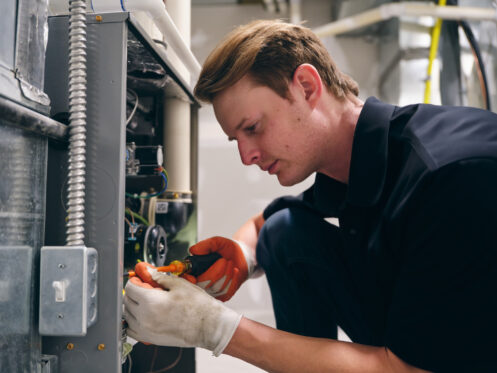During the cold winters in Missouri, it’s very important for homeowners to make sure their furnace is in top working order. A number of problems might develop that compromise the dependability and effectiveness of your heating system. In this blog, we’ll take a look at nine typical furnace issues, explaining what causes them and how to fix them. By promptly addressing these concerns, you can ensure that your house remains warm and cozy during the heating season.
1. Thermostat Malfunctions
Faulty wiring, worn-out parts or incorrect temperature measurements are among the many potential causes of thermostat problems. Uncomfortable temperature control occurs when thermostats are unable to communicate properly with heating systems.
Checking and replacing the batteries, making sure the wiring is secure and making sure the temperature is correctly calibrated are the first steps in fixing a broken thermostat. If difficulties continue, it’s recommended to have a professional check it so you can find and fix the real concerns. During the winter months, it is necessary for homes in Missouri to have a stable and pleasant interior environment, and a timely resolution to thermostat problems is essential for this.
2. Heat Exchanger Problems
The heat exchanger consists of a number of heated tubes contained in a coil, and this is the source of the furnace’s generated heat. The blower pushes air through this coil and over these tubes, sending warm air through the ducts and out the vents. Any dust or debris on the tubes lessens their effectiveness and may cause the coil to crack. The heat exchanger is one of the more expensive parts to replace, and it is one component that our technicians thoroughly clean during a maintenance visit.
3. Ignition Issues
A malfunctioning ignition control, a broken thermocouple or an inadequate gas supply are among the potential sources of ignition difficulties in a furnace. Inadequate heating occurs when the furnace has trouble starting the heating process due to a malfunctioning ignition mechanism. Recurrent ignition attempts, a pilot light that won’t remain lit, or an inability to start at all are signs of this problem. When there are issues with the ignition, it affects the whole heating system, which may be dangerous.
In addition, make sure the pilot light is on and that the furnace has a direct and secure connection to the gas supply. A flickering or nonexistent pilot light causes heating problems because it interferes with the ignition process. Heat that comes on and off, fluctuates in temperature or is completely absent might be the consequence of a malfunctioning pilot light.
You should always make sure the area around the pilot light is clear of obstructions and that the flame is bright and constant. If the flame does not satisfy this criterion, it’s best to get a professional’s help to get to the bottom of things so your heating system can withstand the cold winters in Missouri with ease.
4. Clogged Air Filters
When furnace air filters get clogged, the airflow becomes restricted, which in turn reduces the efficiency and performance of the system. These filters become less effective at letting air pass through as they collect dirt, dust, and other contaminants over time. With less airflow, the furnace has to work harder, which might cause it to overheat and use more energy than necessary. The recirculation of airborne particles is another consequence of inadequate filtering that contributes to poor indoor air quality.
Homeowners should regularly check their filters and replace them in accordance with the manufacturer’s recommendations to prevent air filter blockages. Missourians can easily benefit from a more efficient and effective heating system by performing this maintenance task, which guarantees adequate airflow and reduces strain on the furnace components.
5. Blower Motor Failures
Issues like electrical faults, worn-out bearings or improper maintenance can all cause furnace blower motor failures. When it comes to distributing hot air around the house, a working blower motor is an absolute must. Uneven heating and decreased efficiency result when there’s a breakdown in the furnace’s capacity to disperse warm air. Blower motor problems are preventable with regular maintenance, such as cleaning and lubrication.
6. Strange Noises
Noises like pounding, screeching, or rattling from the furnace that you don’t normally hear might be signs of more serious problems. Issues with the burner assembly, blower motor or worn-out bearings can cause these sounds. Damage to important parts of the heating system, decreased efficiency, and higher energy consumption are all possible outcomes. Ignoring odd sounds could cause bigger issues and more expensive repairs down the road.
As soon as a homeowner hears a peculiar noise coming from their furnace, they should take immediate action by finding any loose components, testing the blower motor and getting expert servicing. Prompt action helps stop more damage, which is essential to your comfort and energy bills.
7. Uneven Heating
Uneven heating in a home can result from issues like blocked vents, duct problems, or a malfunctioning furnace. When some areas receive insufficient warmth, it leads to discomfort and is an inefficient use of energy. Blocked vents or duct obstructions can hinder the proper distribution of heated air, while furnace issues may cause inadequate airflow.
Homeowners should check for and remove obstructions around vents, ensure proper insulation and have a professional inspect the ductwork for leaks or blockages. If problems persist, professional HVAC technicians can identify and address the root cause, restoring balanced and consistent heating throughout the home.
8. No Heat at All
If your furnace isn’t blowing hot air, check for problems with the thermostat, pilot light, or gas valve. Incorrect temperature settings may result from a misconfigured or malfunctioning thermostat, and problems with the pilot light or gas valve can impede ignition.
The first thing a homeowner should do is check the gas valve, the thermostat and whether the pilot light is lit. If troubles continue, have a professional evaluate the furnace to find out what’s wrong. There’s a chance you may need to upgrade to a newer furnace; this is especially true if you have an outdated or older heating system.
9. Frequent Cycling
Problems with the air filter, thermostat or furnace size can lead to frequent cycling of the furnace. In addition to potentially increasing wear and tear, these cycles reduce the heating system’s efficiency. Overheating and increased cycling frequency are symptoms of an air filter that is unclean and blocking airflow. Faulty components, a malfunctioning thermostat, or an undersized furnace might also be to blame.
It is essential to have a professional evaluate the system if cycling problems continue to ensure that you have effective and dependable heating. You can avoid frequent cycling by regularly changing the air filter, verifying the thermostat’s settings, and making sure your furnace is the right size.
Is the furnace in your Saint Peters home causing your problems? If so, Agers Heating & Air Conditioning is here to help. We provide furnace repairs, installations and maintenance, cooling services, indoor air quality products and heat pump maintenance. Contact us today to schedule your next furnace repair.




